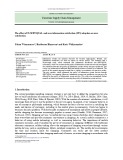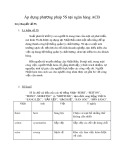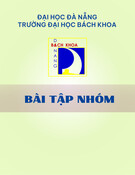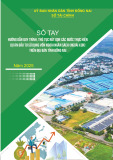
Vol. 7, 2020
A new decade
for social changes
www.techniumscience.com
9 772668 779000
ISSN 2668-7798

Environmental management and recreational facilities usage:
A study of Kainji Lake National Park
Kolawole, G.T.1, Omotayo O.L.1, Adedeji E.O.1, Chikezie., J.1, Deji Joshua1,
Onihunwa, John Ojo1, Elizabeth Abidemi Akintade2
1 Federal College of Wildlife Management, New Bussa, Niger State, Federal
University of Technology, Akure2
owoannes1010@gmail.com
Abstract. Assessment of Environmental and Recreation Facility Maintenance was carried out in
Kainji Lake National Park. Questionnaire method of data collection was employed to collect the
data needed. Purposive and simple random techniques were adopted to sample respondents in
the study area. One hundred questionnaires were designed and administered. The data collected
were analyzed through simple percentage and presented in table and charts. However, the results
showed that recreation facilities are 99% present, while swimming pool is 65% functional. The
study showed that visitors came there three times in a week indicating 44% of the respondents
while on maintenance of the park environment and the facilities indicated 94% and 88% of the
respondents respectively. The study further recommended the followings facilities basketball
pitch. Hockey game, volley ball and well-constructed swimming pool.
Keywords. Environment, Maintenance, Recreation, Facilities, Usage and Park
Background of the study
While there may be a temptation to think of recreation as trivial, even frivolous, most
of us know better. As paradoxical as it might seem, recreation is a serious matter. The
importance of recreation manifests itself in a number of ways. Perhaps the most obvious to
readers of the George Wright forum is the philosophical and legal foundation of U.S National
Park as laid down in the National Park Service of Organic Act Of 1916. While national parks
are clearly to be conserved, they are also to “provide for the enjoyment of the people. This two
– fold mission is at the heart of most public parks and related areas. Thus, recreation, in a variety
of forms is vital even integral top parks.
The etymology of the word ‘recreation” is also suggestive of the importance of its role
in society rooted in the Latin “recreation” and “recreare” “recreation” means respectively “to
refresh” and “to restore” (Edginton, eta al., 2002). Given the increasing Dace and stress of
contemporary society, it seems likely that recreation will continue to grow in importance, and
that parks will likewise escalate in importance for their role in providing public recreation. The
social importance of recreation is further reflected in the professional activity and literature that
has grown up around it. There is a received history of the “recreation movement” in the US, a
social movement designed to provide the benefits of recreation to all Americans. Students can
now earn degree in recreation, parks and a related field at over 50 colleges requires information
276
Technium Social Sciences Journal
Vol. 7, 276-282, May 2020
ISSN: 2668-7798
www.techniumscience.com

on values of recreation. Whether for damage assessment or Government Performance and
Results Act (GPRA) of 1993 these requirement feeds directly into a need for credible measures
of benefits. Tourism and protected areas have been intimately related for centuries with notable
implications. Since, or perhaps even before, the establishment of yellow stone in 1872. Tourism
has been much depending on the outstanding natural lands Cape in protected areas for its
survival and to operate. In 2004, the segment of tourism in natural areas grew three times faster
than the entire tourism industry as a whole. This growth is believed to be also result from the
increase in the number of protected area worldwide. According to IUCN and WCMC (2003),
the number of protected areas worldwide had grown 1, 000 in 1960s to over 100, 000 in 2002.
A protected area is defined as areas of land and or sea especially dedicated of natural and
associated cultural resources and managed through legal or other effective means. Based on the
principles of sustainable tourism, tourism is able to support these roles of parks (Driver, 1990;
Driver 1996; Stein and Lee 1995; Allen 1996). Recreation activities are basic tools for people’s
empowerment there are several benefits derivable from recreation if properly harnessed and the
environment are properly maintained. However the environmental maintenance and
recreational facilities of some parks are under maintained because of some reasons peculiar to
them.This will however make this work to focus on Kainji Lake National Park.
The aims of this research work are to: access on the recreational facilities available at
Kainji Lake National Park,to examine the level of maintenance of the recreational facilities at
Kainji Lake National Park, to access the maintenance of the park environment for visitors
delight.
Methodology
This study made use of quantitative method (the use of questionnaire to collect data
from respondents. A total of 100 respondents were drawn through simple random and
systematic sampling in the park.Questionnaire as the major instrument designed for data
collection. The questionnaire was designed to contain questions that were related to the topic
of the research.The target populations for this study were staff of the park and also tourists of
both sexes (male and female).Purposive and simple random techniques were employed to
sample respondents for this study, thus, 100 questionnaires were design and administered to the
staff of the park.
Presentation of data/results
Descriptive statistics were employed for the data analysis where result were shown in
table, charts etc.
Table 1: Availability of recreational facilities
Options Frequency Percentage
Yes
99
99
No
1
1
Total
100
100%
277
Technium Social Sciences Journal
Vol. 7, 276-282, May 2020
ISSN: 2668-7798
www.techniumscience.com

Figure 1
According to the above on the whether recreational facilities are available in the park
99% of the respondents in the study area claimed that recreational facilities are available while
1% of the respondents said no.
Table 2: Identified recreational facilities
Options Frequency Percentage
Swimming pool
65
65
Table tennis
14
14
Football pitch
11
11
Basketball court
10
10
Total
100
100%
Figure 2
The above on the identified recreational facilities 65% of the respondents claimed that
swimming pool is available and much more functional than other facilities while followed by
table tennis which stands at 14%. The reason for the low responses is attached with the
improvement that the facilities needed.
Series1,
Yes , 99,
99%
Series1,
No, 1, 1%
Yes
No
Swimming
Pool
Table Tennis Football
Pitch
Basketball
Court
Series1 65 14 11 10
Series1,
Swimming
Pool, 65
Series1, Table
Tennis, 14
Series1,
Football
Pitch, 11
Series1,
Basketball
Court, 10
278
Technium Social Sciences Journal
Vol. 7, 276-282, May 2020
ISSN: 2668-7798
www.techniumscience.com

However, the facilities recommended for recreation purposes are listed below;
i. New basketball field
ii. Hockey pitch
iii. Lawn tennis court
iv. Well-equipped museum
v. Bat mitting
vi. Volleyball pitch.
Table 3: Tourist patronage
Options Frequency Percentage
Weekly
65
65
Once a year
14
14
3 times a week
11
11
Total
100
100%
Figure 3
The chart above shows that tourists come to the park three times in a week have 44%
of the total respondents, while those that come there weekly 38% of the respondents followed
by those that come their once in a year which have 18% of the respondents.
Table 4: Level of maintenance of recreational facilities
Options Frequency Percentage
Yes
88
88
No
1
2
1
2
Total
100
100%
Series1,
Weekly ,
38, 38%
Series1,
Once a
Year , 18,
18%
Series1, 3
Times a
Week, 44,
44%
Weekly
Once a Year
3 Times a Week
279
Technium Social Sciences Journal
Vol. 7, 276-282, May 2020
ISSN: 2668-7798
www.techniumscience.com










![Hệ thống quản lý chất lượng Q-BasePage tốt nhất: [Hướng dẫn chi tiết]](https://cdn.tailieu.vn/images/document/thumbnail/2013/20130626/yenhoangbank321/135x160/2641372217840.jpg)








![20 câu hỏi Quản lý dự án phần mềm có đáp án [mới nhất]](https://cdn.tailieu.vn/images/document/thumbnail/2025/20251003/hieu2004haha@gmail.com/135x160/78791759734259.jpg)


![Tài liệu Quản lý dự án: Kiến thức nền tảng toàn diện [chuẩn SEO]](https://cdn.tailieu.vn/images/document/thumbnail/2025/20250910/kimphuong1001/135x160/92631757496585.jpg)



